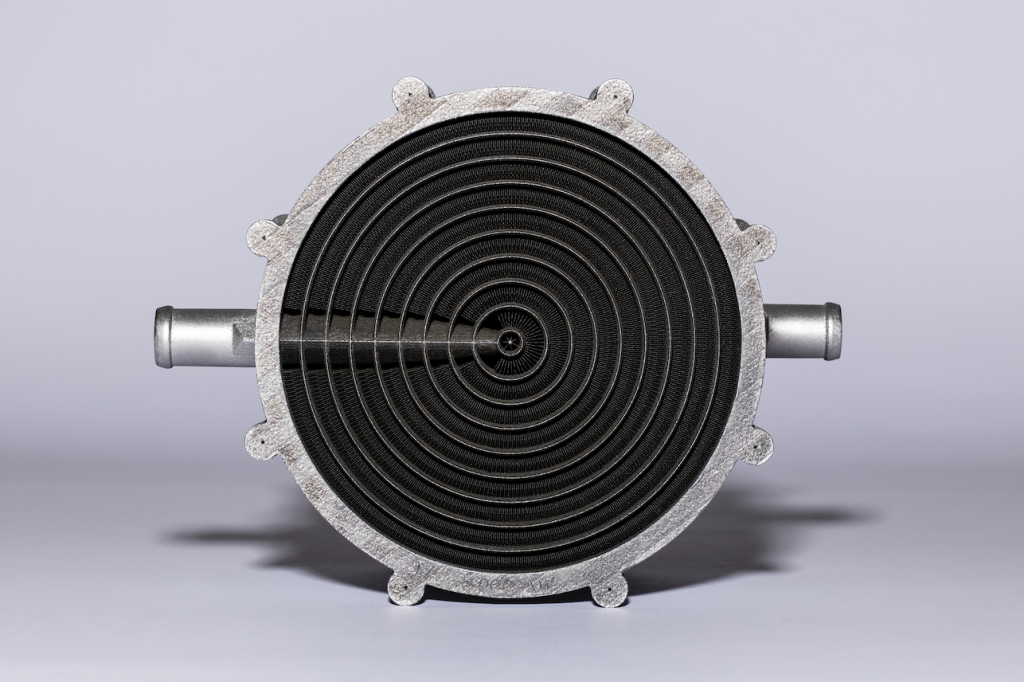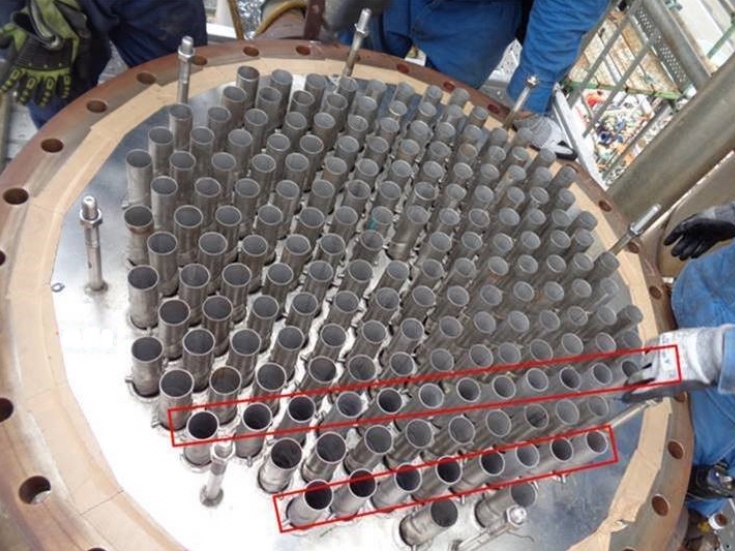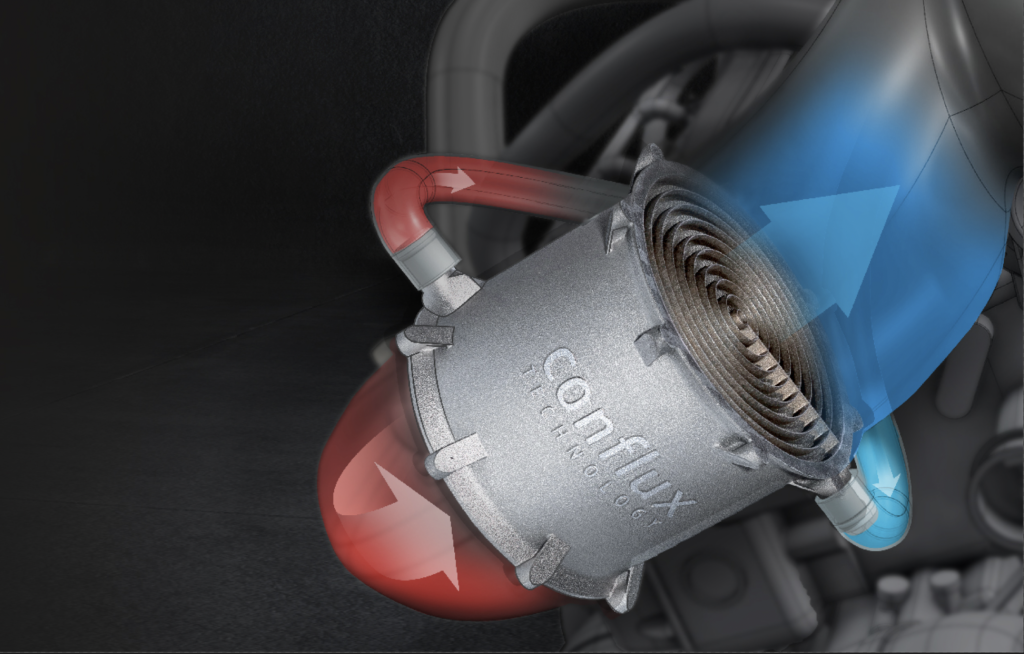Heat transfer specialist Conflux Technology has announced the commercial launch of its first pre-designed 3D printed product.
Built on the back of Conflux’s prior heat exchanger R&D, its Water Charge Air Cooler or ‘WCAC,’ is designed to cool the air that enters the turbos used to boost some cars’ engines. Utilizing 3D printing, it’s said that the firm is able to not just optimize the device’s weight and performance, but to scale its dimensions in a way that allows it to slot into the existing designs of high-end automotive manufacturers.
“The Conflux WCAC embodies how we deliver what motorsport and elite auto makers ask for – a definitive performance advantage,” explains Dan Woodford, Conflux’s new Chief Product Officer. “A product is rapidly configured to our customer’s prioritization of performance, size, and packaging requirements. AM lets us supply the WCAC with low lead times and competitive pricing.”

Conflux’s ‘productization’ shift
A specialist in the use of 3D printing for thermal and fluid management applications, Conflux was founded in 2017 by engineer Michael Fuller. Using the knowledge accrued during his time working in F1, the World Rally Championship and Le Mans motor racing, Fuller and his firm are now seeking to disrupt a heat exchanger market it values at $16.6 billion.
At present, Conflux offers a range of application development, design, prototyping and low volume-production services, via its suite of powder bed fusion systems. The company’s 3D printing capabilities are also backed by its computational heat transfer simulations, which enable the creation of optimized heat exchangers, with automotive, aerospace and defense applications, amongst others.
Since gaining an initial investment from AM Ventures five years ago, Conflux has managed to raise a further $8.5 million (AUD) to fund its R&D ambitions. In one recent initiative, the company has begun using the ‘Synchrotron’ particle accelerator to inspect its parts at a sub-macroscopic level, while in another, it has teamed up with Deakin University to develop novel 3D printing aluminums.
Just last month, Conflux also unveiled a partnership with GKN Aerospace that will see the latter’s technology used to 3D print heat exchangers for European clients. However, with the launch of its WCAC, the company has announced a significant shift away from its traditional service-driven model, and into a product-driven one, in a step it considers to be the first in an “ongoing productization strategy.”
“I am really excited about the product roadmap for Conflux Technology’s AM heat exchangers,” adds Woodford. “The team has made significant strides developing in-house tools that deliver very high performance without compromising quality. I am really proud of everyone at Conflux for launching the next phase of our business with the WCAC product line.”
“Conflux has aggregated our expertise in first principles calculations, core engineering design and additive manufacturing into a set of tools that can rapidly inform a solution.”

A turbocharger-cooling device debut
In effect, a charge air-cooler is a device often deployed between the compressor and engine inlet valve of a performance vehicle, which uses a liquid to cool the hot air being ejected by its turbocharger. Often cited as a more efficient alternative to traditional air-to-air intercoolers, such devices can also be used in pursuit of performance, as a means of pumping higher density air into the engine bay.
Drawing on its long-established expertise in heat exchanger development, Conflux is now aiming to optimize this process, by developing its own air-cooling device that outperforms existing products. Compared to current microtube WCACs, the firm’s is said to feature a 15% smaller core volume, while enabling a reduction of 24% and 82% respectively, when it comes to air-side and coolant pressure drops.
Additionally, leveraging 3D printing, Conflux says it’s able to produce its WCAC in such a way that it can be configured for the custom boundary conditions, performance and packaging requirements of users’ vehicles. With this in mind, the company is marketing the device towards motorsport and high-end automotive clients, the likes of which have been quick to complement it at a recent trade show.
“Customers were commenting on both the detail of the parts and the surface finish,” says Ben Batagol, Conflux’s Head of Business Development. “They couldn’t believe the level of detail within the WCAC and how it was designed. It solidified their understanding that Conflux is a long way ahead of our competitors with what we showcased.”
“Customers responded with amazement and disbelief as they held a part designed by our engineers embedding complex AM geometries into a production-ready WCAC.”

Advancing heat exchanger 3D printing
Conflux has no doubt put itself at the cutting edge of heat exchanger design, but it’s far from the only firm using 3D printing in this area. Late last year, 3D Metalforge also revealed that it had managed to produce and ship 3D printed heat exchanger parts to Shell. Installed at Shell’s site on Jurong Island, the durability-enhanced components have essentially helped minimize equipment downtime there.
At the University of Illinois at Urbana-Champaign, meanwhile, researchers have used 3D printing to boost heat exchanger performance by up to 2000%. To make this possible, the team has developed their own purpose-built design software with topology optimization functionality. The program effectively optimizes existing heat exchanger designs to maximize heat transfer while minimizing part weight.
In the past, the likes of GE Research have also worked with colleagues at the University of Maryland and Oak Ridge National Laboratory to 3D print a heat exchanger that’s resistant to temperatures of up to 900°C. The device features a unique grape-like geometry, which provides it with the extreme heat and pressure resistance needed to outperform state-of-the-art devices by more than 200°C.
To stay up to date with the latest 3D printing news, don’t forget to subscribe to the 3D Printing Industry newsletter or follow us on Twitter or liking our page on Facebook.
For a deeper dive into additive manufacturing, you can now subscribe to our Youtube channel, featuring discussion, debriefs, and shots of 3D printing in-action.
Are you looking for a job in the additive manufacturing industry? Visit 3D Printing Jobs for a selection of roles in the industry.
Featured image shows a diagram depicting how Conflux’s new Water Charge Air Cooler works. Image via Conflux Technology.
